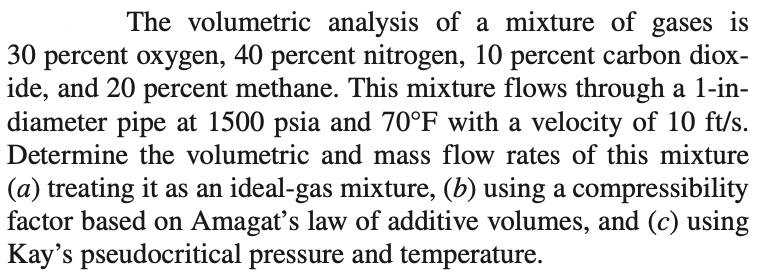The volumetric analysis of a mixture of gases is 30 percent oxygen, 40 percent nitrogen, 10 percent carbon diox- ide, and 20 percent methane. This mixture flows through a 1-in- diameter pipe at 1500 psia and 70°F with a velocity of 10 ft/s. Determine the volumetric and mass flow rates of this mixture (a) treating it as an ideal-gas mixture, (b) using a compressibility factor based on Amagat's law of additive volumes, and (c) using Kay's pseudocritical pressure and temperature.
The volumetric analysis of a mixture of gases is 30 percent oxygen, 40 percent nitrogen, 10 percent carbon diox- ide, and 20 percent methane. This mixture flows through a 1-in- diameter pipe at 1500 psia and 70°F with a velocity of 10 ft/s. Determine the volumetric and mass flow rates of this mixture (a) treating it as an ideal-gas mixture, (b) using a compressibility factor based on Amagat's law of additive volumes, and (c) using Kay's pseudocritical pressure and temperature.
Elements Of Electromagnetics
7th Edition
ISBN:9780190698614
Author:Sadiku, Matthew N. O.
Publisher:Sadiku, Matthew N. O.
ChapterMA: Math Assessment
Section: Chapter Questions
Problem 1.1MA
Related questions
Question
100%
Not Ai generated, please show all steps
The volumetric analysis of a mixture of gases is
30 percent oxygen, 40 percent nitrogen, 10 percent carbon diox-ide, and 20 percent methane. This mixture flows through a 1-in-diameter pipe at 1500 psia and 70°F with a velocity of 10 ft/s.
Determine the volumetric and mass flow rates of this mixture
(a) treating it as an ideal-gas mixture, (b) using a compressibility factor based on Amagat's law of additive volumes, and (c) using Kay's pseudocritical pressure and temperature.

Transcribed Image Text:The volumetric analysis of a mixture of gases is
30 percent oxygen, 40 percent nitrogen, 10 percent carbon diox-
ide, and 20 percent methane. This mixture flows through a 1-in-
diameter pipe at 1500 psia and 70°F with a velocity of 10 ft/s.
Determine the volumetric and mass flow rates of this mixture
(a) treating it as an ideal-gas mixture, (b) using a compressibility
factor based on Amagat's law of additive volumes, and (c) using
Kay's pseudocritical pressure and temperature.
Expert Solution
This question has been solved!
Explore an expertly crafted, step-by-step solution for a thorough understanding of key concepts.
This is a popular solution!
Trending now
This is a popular solution!
Step by step
Solved in 2 steps with 6 images

Recommended textbooks for you

Elements Of Electromagnetics
Mechanical Engineering
ISBN:
9780190698614
Author:
Sadiku, Matthew N. O.
Publisher:
Oxford University Press

Mechanics of Materials (10th Edition)
Mechanical Engineering
ISBN:
9780134319650
Author:
Russell C. Hibbeler
Publisher:
PEARSON

Thermodynamics: An Engineering Approach
Mechanical Engineering
ISBN:
9781259822674
Author:
Yunus A. Cengel Dr., Michael A. Boles
Publisher:
McGraw-Hill Education

Elements Of Electromagnetics
Mechanical Engineering
ISBN:
9780190698614
Author:
Sadiku, Matthew N. O.
Publisher:
Oxford University Press

Mechanics of Materials (10th Edition)
Mechanical Engineering
ISBN:
9780134319650
Author:
Russell C. Hibbeler
Publisher:
PEARSON

Thermodynamics: An Engineering Approach
Mechanical Engineering
ISBN:
9781259822674
Author:
Yunus A. Cengel Dr., Michael A. Boles
Publisher:
McGraw-Hill Education

Control Systems Engineering
Mechanical Engineering
ISBN:
9781118170519
Author:
Norman S. Nise
Publisher:
WILEY

Mechanics of Materials (MindTap Course List)
Mechanical Engineering
ISBN:
9781337093347
Author:
Barry J. Goodno, James M. Gere
Publisher:
Cengage Learning

Engineering Mechanics: Statics
Mechanical Engineering
ISBN:
9781118807330
Author:
James L. Meriam, L. G. Kraige, J. N. Bolton
Publisher:
WILEY